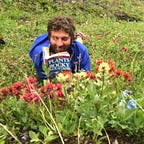The Echoes of Rwanda
From Darfur to the Islamic State — the media’s coverage of mass atrocity contains many echoes of the Rwanda genocide
The seventh panel at the Media and Mass Atrocity round table on Dec. 3 explored more recent examples of genocide and mass atrocity.
Panellists included: Michael Petrou, a 2017 Nieman Fellow at Harvard University, Joachim Savelberg from the Department of Sociology at the University of Minnesota, and media consultant Michelle Betz.
Michael Petrou:
Michael Petrou gave a presentation on the Islamic State’s media strategy and the Yazidi genocide.
The genocide has led to the exile of the Yazidis from Northern Iraq. Since 2014, thousands of men, women and children have been killed, raped or captured and converted to Islam.
The conflict is ongoing.
At the beginning of his presentation, Petrou said one of the strengths of the Islamic State’s media is its innovation.
https://soundcloud.com/sirliam/michael-petrou-on-how-the-islamic-state-media-became-innovative
Hundreds of media products have been produced by the Islamic State, including anything from feature films to simple photos. The media efforts are meant to propagate an image of the Islamic State as a functioning wealthy welfare state that looks after its own people.
However, the state’s media machine also propagates messages against certain ethnicities, such as Shias, Jews and Christians.
The videos produced by the Islamic State, said Petrou, are clearly meant for supporters. Not only are they meant for “blood lust” but also to be used as a “weapon of fear.”
Petrou ended his presentation by asking how international journalists should respond to the Islamic State’s representation of itself.
What is the “news value” in showing beheadings, or the moments prior to beheadings on western news, he asked.
Although, it’s important to show who and what the Islamic State is, Petrou said,“I don’t think we have to see someone being burnt alive to see what the Islamic State is.”
Joachim Savelberg:
Joachim Savelberg presented his paper concerning journalism on Darfur and why particular narratives “triumph” over others in international media.
Savelberg researched media coverage during the Darfur conflict from 2003 to 2010.
In 2003, when violence erupted in the region, he said there were “virtually no media reports,” even as the first massive waves of killing occurred.
International coverage increased during the subsequent years only to decrease yet again in 2010. Savelberg posited that these “drips” owed to the fact that journalists and audiences “were tired” of the genocide narrative.
He did note, however, that Darfur is also difficult to enter and that at times there are almost no journalists allowed in the region.
Savelberg has studied what narratives were being reported and to what audiences.
The most common narrative reported during the Darfur conflict, he said, had to do with criminal justice. Criminal justice refers to groups or individuals who threaten or cause harm to the social order, such as customs, values, and institutions in a particular country.
This particular narrative wasn’t unique to Darfur. Savelberg said he saw the same narrative emerge in the media coverage of the wars in Yugoslavia. He reasoned the narrative was popular due to its depiction of the use of power and its misuse, casting light on corruption and violence.
However, Savelberg said this narrative is restrictive and comes at a price as it only focuses on just a few individuals and not “the big picture.” For example, it may just focus on the who-what-where-when of crime and not why the crime was committed.
Savelberg also found that in the U.S., when reporting on Darfur the media used the term genocide more often than other countries.
Michelle Betz:
Michelle Betz spoke of her experience working with journalists in the Central African Republic (CAR).
She began her presentation by asking those gathered to imagine themselves living the life of a journalist in the Central African Republic.
The country you live in has descended into war. Radio stations are looted, family members killed, and death threats become common.
As Betz spoke, a slide show played with the name of journalists currently reporting in CAR.
Samuel Bogoto…Davy Kpenouwen…Hippolyte Donossio
And one that had been killed— Blanche Elisabeth Olofio.
The Central African Republic is one of the poorest countries in the world. The current conflict started in 2012, and began to “heat up” in 2013. Most international media outlets depict the crisis as being fought along religious lines: Christians vs. Muslims.
The confliect, however, is much more complicated.
Betz said, one way the international community could help CAR, was to not refer to the conflict as genocide.
https://soundcloud.com/sirliam/michelle-betz-saying
She described how hate speech and hate media is common in the country. To stop the spread of hate, journalists in the country either self-censor or do not report on it. Nevertheless, it doesn’t stop the spread and can put journalists in danger.
Betz said that if rebels or militias do not like what a journalist in the Central African Republic reports or if they refuse to spread propaganda, it could result in the journalist’s death.
https://soundcloud.com/sirliam/michelle-betz-2
Despite the dangers associated with the job, Betz said journalists carry on as they did before the conflict began.
“These journalists are so committed to what they do. They know their job is more important than ever. They will not give in, they will not quit.”
Betz left the audience with the following question: How does trauma affect how journalists report on a daily basis?
She said that there has been little research done to understand trauma and stress and she hopes more resources will be used to develop treatment and culturally appropriate coping methods.
